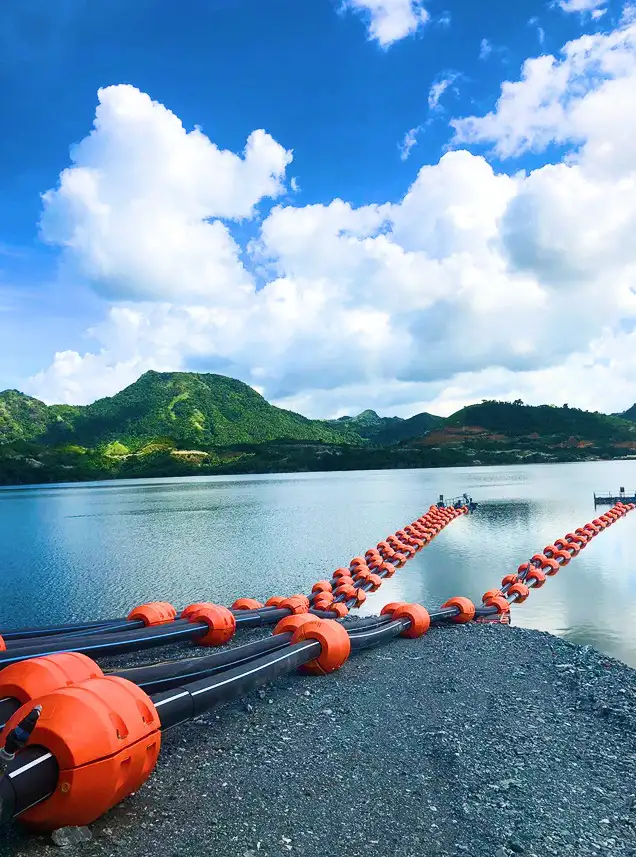A pipe floater, also known as a dredge float, pipe collar, or pontoon, is a buoyant module attached to a pipeline to make it float on the surface of the water. They are typically designed as two "clam-shell" halves that bolt together around the pipe.
The main purpose is to provide buoyancy to pipelines used in marine environments. This keeps the pipeline on the water's surface, preventing it from sinking and allowing it to follow the movement of dredging or pumping equipment. It also makes the pipeline's location clearly visible.
You may hear them called: Dredge Floats / Dredging Floats Pipe Pontoons Hose Floats / Hose Collars Pipeline Buoys Floating Collars
Most modern pipe floaters consist of two main components: Outer Shell: Made from a tough, impact-resistant, and UV-stabilized polymer, typically Medium-Density Polyethylene (MDPE) or High-Density Polyethylene (HDPE). This shell protects against collisions, sunlight, and marine growth. Inner Core: Filled with a closed-cell polyurethane (PU) foam. This foam provides the buoyancy and ensures the floater will not sink even if the outer shell is punctured.
This is the most critical question. You need to calculate the total weight the floaters must support. The total buoyancy provided by the floaters must be greater than the total weight of the pipeline and its contents. Key factors to consider: Pipe Outer Diameter (OD): The floater's inner diameter must match the pipe's outer diameter for a secure fit. Pipe Weight: The weight of the empty pipe per meter or foot. Contents Weight: The weight of the material (slurry, water, etc.) inside the pipe. This is determined by the slurry's specific gravity or density. Ancillary Equipment: The weight of any flanges, bolts, or other hardware on the pipeline. Required Freeboard: How high you want the pipeline to sit out of the water. A higher freeboard provides more stability in rough conditions. Rule of Thumb Calculation: Total Floater Buoyancy ≥ (Weight of Empty Pipe + Weight of Contents) x Safety Factor A common safety factor is 2, meaning the floaters should provide at least twice the buoyancy needed to just float the filled pipe. Always consult your manufacturer for precise calculations.
Pipe floaters are essential in any industry that moves liquids or slurries via pipelines over water. Key industries include: Dredging: For sand, silt, and gravel extraction from seabeds, rivers, and lakes. Mining: For transporting tailings and slurries in tailing ponds. Wastewater Treatment: For aeration lines and outfall pipelines. Civil Construction: For dewatering projects and marine construction. Aquaculture: For water circulation and feed delivery systems.
Yes. They are designed for both. The key is to match the floater's internal diameter to the outer diameter of the hose or pipe (like HDPE or steel) it will be supporting.
Installation is straightforward: Place one half of the floater shell underneath the pipe. Place the top half over the pipe, aligning it with the bottom half. Insert the galvanized or stainless steel bolts through the mounting holes. Secure them with nuts and washers, tightening them evenly until the floater is snug on the pipe. Do not over-tighten, as this can damage the plastic shell.
They are very low-maintenance. However, periodic inspection is recommended: Check Hardware: Ensure all nuts and bolts are still tight. Inspect Shell: Look for any major cracks or punctures from collisions. Check Position: Make sure the floaters haven't slipped along the pipe.
Minor cracks or holes in the outer polyethylene shell can often be repaired using plastic welding techniques. If the damage is severe and has compromised the inner foam core, the floater should be replaced.
To get the best recommendation and quote from a manufacturer, provide the following details: Pipe Material: (e.g., HDPE, Steel, Rubber Hose) Pipe Outer Diameter (OD) Pipeline Length Specific Gravity (Density) of the Slurry/Liquid Operating Environment: (e.g., Calm lake, rough sea, high-current river) Desired Freeboard or Safety Factor
To save on shipping costs, pipe floater halves are typically "nested" (stacked inside each other) and loaded onto pallets or directly into shipping containers. This significantly reduces the volume of the shipment.
